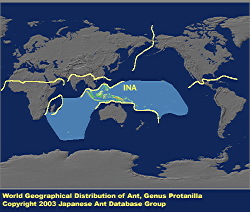
|
genus
|
Protanilla
|
 |
Japanese Name
|
Juzufushi-ari-zoku
|
Original Reference
|
|
Bolton, B. (1990) The higher classification of the ant subfamily Leptanillinae. Systematic Entomology 15: 267-282.
|
Description
|
|
Mandibles elongate triangular, down-curved, without vertical lamella; outer surface with longitudinal groove; inner face with several peg-like setae. Labrum with spiniform teeth.
|
|

|
Remarks
|
|
The mandibles of Protanilla function as trap jaws (see Hoelldobler & Wilson (1990) Fig. 16-18, p. 592), opening almost 180 degrees and closing sharply when clypeal and mandibular sensory setae are triggered. Authorship of the type species, Protanilla rafflesi, was attributed to Taylor by Bolton (1990), but the description gave only measurement details, so that further characterization is desired. Although only one species has been described, Protanilla is known to range from Nepal to Sri Lanka, Singapore, Borneo and Japan. There are several known undescribed species, including the following Japanese taxon (Taylor, pers. com.; Bolton, 1990). Myrmecological Society of Japan Editorial Committee (1988) nominated two Japanese names for this ant, but later examination has shown that these were applied a single species.
|
References
|
|
- Hoelldobler, B. & E. O. Wilson (1990). The ants. . , 732.
- Bolton, B. (1990). The higher classification of the ant subfamily Leptanillinae (Hymenoptera: Formicidae). Syst. Ent., 15, 267-282.
- International Trust for Zoological Nomenclature, 1985
- Myrmecological Society of Japan, Editorial Committee (ed.) (Ed.). (1988). A list of the ants of Japan with common Japanese names. The Myrmecological Society of Japan, Tokyo.
|
Editor
|
|
Original text by Keiichi Onoyama and Kazuo Ogata. English translation by Kazuo Ogata, edited by Robert W. Taylor.
|
|